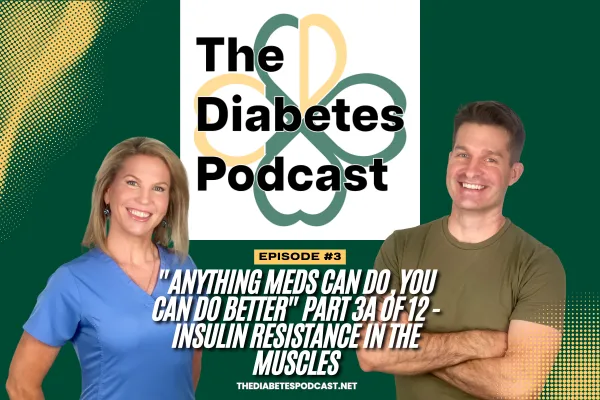
EP003 - Diabetes Dirty Dozen - Part 3A
Muscle Insulin Resistance, Part 1: How Your Muscles Can Lower Blood Sugar
“After meals, about 80% of glucose uptake happens in skeletal muscle. Your muscles are the biggest lever to pull sugar out of your bloodstream.” - Amber
Welcome to The Diabetes Podcast blog. We’re Amber (RD/LD, CDCES) and Richie (TRS-C). Today we’re breaking down muscle insulin resistance in simple terms. This is Part 1 of a 2-part series from our “Anything meds can do, you can do better” roadmap.
Big promise: you can use your muscles to lower blood sugar. No guilt. No shame. Just clear steps.
What Is Insulin? The “Key and Lock” Explained
Insulin is a hormone made by your pancreas.
Think of insulin as a key.
The key unlocks your cells (muscle, liver, and fat) so sugar (glucose) can get inside to be used for energy or stored for later.
When insulin works:
Sugar moves out of your blood and into cells.
The liver stores some as glycogen.
Extra can be stored in muscles or as body fat.
The liver is told to “slow down” sugar production.
High insulin puts your body in storage mode. Burning fat gets harder.
What Is Insulin Resistance?
The locks (your cells) get “gunked up.” The insulin key doesn’t work well.
Your pancreas pushes out more insulin to try to force the door open.
Causes often include:
Too much refined food (white bread, sugary drinks, ultra-processed snacks).
Not enough movement.
Visceral fat (belly/organ fat) and genetics.
Poor sleep and chronic stress (high cortisol).
Why High Insulin Makes Fat Loss Hard
Higher insulin = stronger “store” signal.
Fat burning still happens, but it’s less effective.
This is a big reason fat loss feels slow when insulin is high.
How Do I Know If I Have Insulin Resistance?
You often can’t “feel” it. It happens quietly for years.
Ask your doctor for a fasting insulin test (8–12 hours without food).
A fasting insulin above about 10–12 micro-units/mL is a red flag.
Note: results can vary by lab, stress, sleep, and recent exercise.
A1C is a 3-month lookback. Insulin resistance can exist 10–20 years before diabetes shows up on A1C or fasting glucose.
Consider testing if you have belly fat, family history, or concerns about metabolic health.
Metabolic Ripple Effect: Why This Matters Beyond Sugar
With insulin resistance, fat cells can get “leaky,” spilling free fatty acids into the blood.
The liver repackages these into triglycerides and VLDL (very low-density lipoproteins).
VLDL are small and dense. They can slip into vessel walls, oxidize (like rust), and set the stage for plaque and clots.
HDL (the “cleanup crew”) can be disrupted by high triglycerides, lowering its protective effect.
More visceral fat = more inflammation = more insulin resistance. It becomes a cycle.
The 80% Rule: Your Muscles Are the Main Sugar Sink
After meals, about 80% of glucose uptake can happen in skeletal muscle.
Translation: your muscles are the biggest lever to pull sugar out of your bloodstream.
The Magic of Movement: An Insulin-Independent Pathway
When you move, your muscles can pull in sugar without needing insulin to “unlock” the door. Here’s how:
Muscle contraction flips on an energy sensor called AMPK.
AMPK signals GLUT4 transporters (the cell’s “glucose doors”) to move to the cell surface.
RAC1 helps rearrange the cell so GLUT4 can get to the surface.
Result: more doors open, sugar flows into muscle, and blood glucose drops—even if insulin isn’t working well.
Bonus:
Better blood flow to muscles.
Mitochondria (your cell power plants) work better.
Insulin sensitivity can improve for up to 48 hours after exercise.
Real-Life Story: The Missed Walk
One client walked 30–60 minutes every other day. His blood sugars were rock-solid—until a two-day break. His readings jumped all day long. When the walking routine stopped, the 48-hour effect faded. When he resumed, his numbers improved again. Movement matters.
How Little Movement Makes a Big Difference
A 30-minute brisk walk can significantly reduce post-meal spikes, even after higher-carb meals.
Even 2–5 minutes of light walking after a meal helps improve blood sugar.
Ten-minute walks after each main meal lowered post-meal blood sugar more than one single 30-minute walk done at another time.
What This Means for You
Best timing: move right after meals.
Minimum barrier: 2 minutes is better than zero. Make it a habit trigger: “I eat, I stroll.”
Great target: 10 minutes after breakfast, lunch, and dinner.
Gold star: 30-minute brisk walks as able, especially after meals.
Consistency counts: keep the 48-hour window alive by moving most days.
Common Questions
Do I need a gym? No. Walk, march in place, do gentle stairs, or light housework.
What if I have joint pain? Try seated marches, arm ergometers, gentle bands, or water walking.
What if I already take meds? Keep moving. This pathway works alongside medication.
Is more always better? Don’t overdo it. Build slowly. The habit beats the hero workout.
Recap
Muscle insulin resistance keeps sugar stuck in your blood.
Movement opens the door without insulin.
Your muscles handle up to 80% of post-meal glucose when they’re active.
Short walks after meals can lower spikes, insulin, and triglycerides.
This is a simple, low-cost tool you can use today.
What’s Next (Part 2)
In Part 2, we’ll cover:
Medications aimed at muscle insulin resistance.
Pros and cons you should know.
More step-by-step strategies you can do to improve muscle insulin resistance.
If this helped, share it with a friend and subscribe to The Diabetes Podcast. Ready for support? Got more questions? Send them to [email protected]. Your healthiest chapter starts now. Take courage! You can do this, and we can help.
Disclaimer
The information in this blog post and podcast is for educational and informational purposes only. It is not medical advice, diagnosis, or treatment, and it does not replace a one-on-one relationship with your physician or qualified healthcare professional. Always talk with your doctor, pharmacist, or care team before starting, stopping, or changing any medication, supplement, exercise plan, or nutrition plan—especially if you have diabetes, prediabetes, heart, liver, or kidney conditions, or take prescription drugs like metformin or insulin.
Results vary from person to person. Examples, statistics, or studies are shared to educate, not to promise outcomes. Any discussion of medications, dosing, or side effects is general in nature and may not be appropriate for your specific situation. Do not ignore professional medical advice or delay seeking it because of something you read or heard here. If you think you are experiencing an emergency or severe side effects (such as persistent vomiting, severe diarrhea, signs of dehydration, allergic reaction, or symptoms of lactic acidosis), call your local emergency number or seek urgent care right away.
We strive for accuracy, but health information changes over time. We make no guarantees regarding completeness, timeliness, or suitability of the content and assume no liability for actions taken or not taken based on this material. Use of this content is at your own risk.
Links or references to third-party resources are provided for convenience and do not constitute endorsement. By reading, listening, or using this information, you agree to these terms and understand that you are responsible for your own health decisions in partnership with your licensed healthcare provider.

